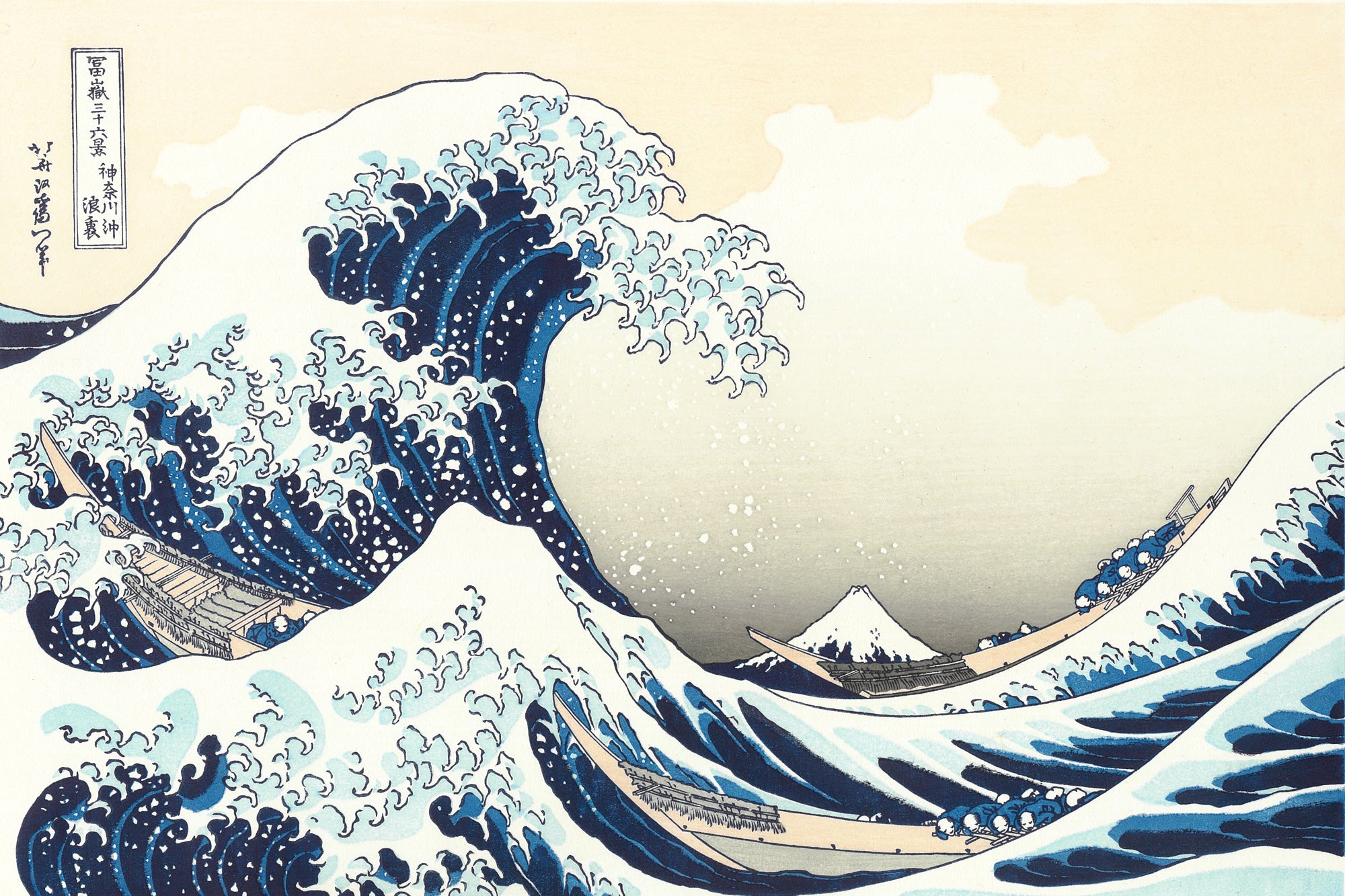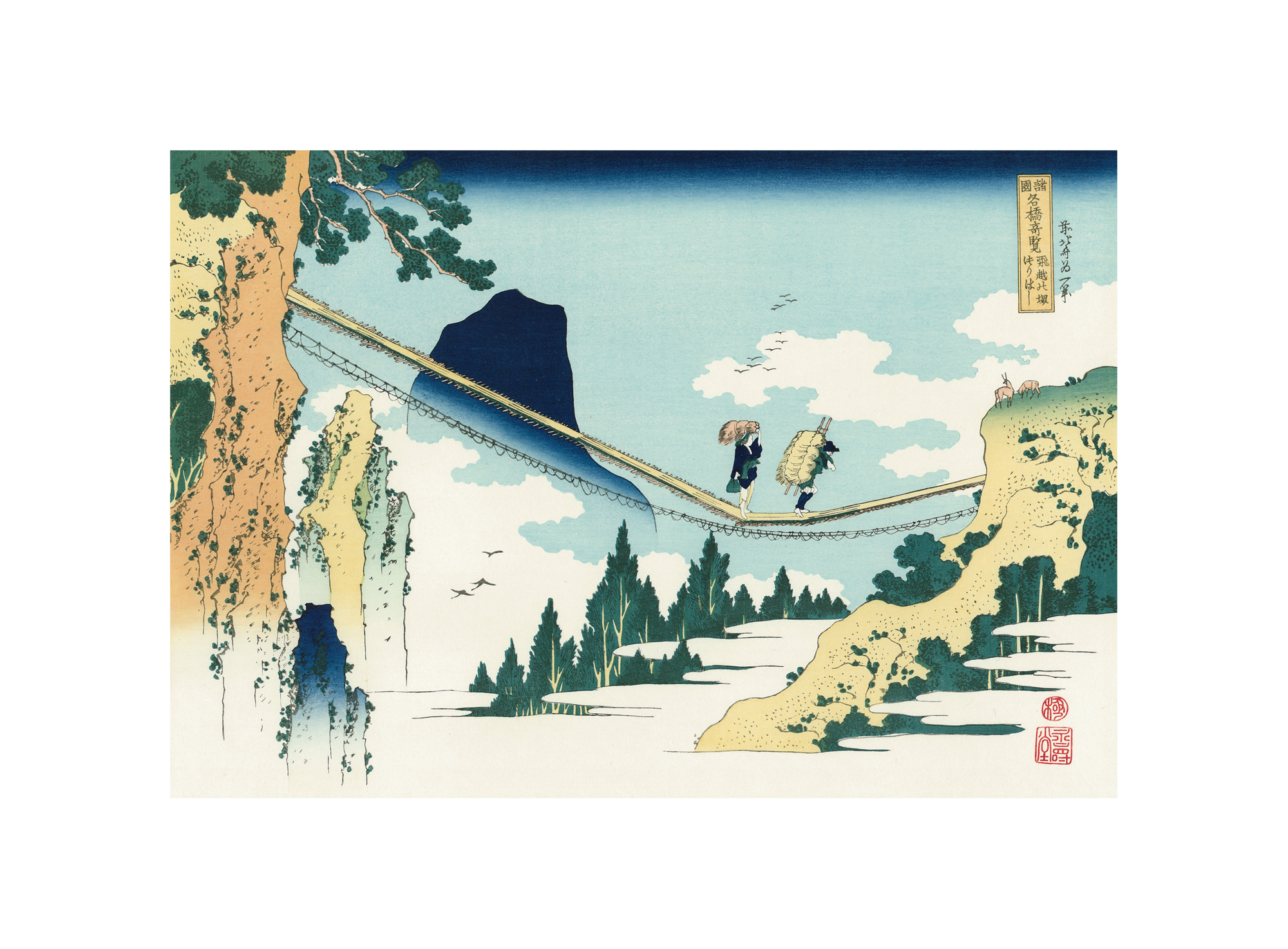
Katsushika Hokusai
Katsushika Hokusai (1760-1849)
Hokusai produced his very first print in 1779 at the age of twenty. It was an actor print in the hosoban format signed Katsukawa Shunro. He built his career by creating more actor prints but was mainly active as a book illustrator.Hokusai also produced paintings throughout his life and his works surpassed those of other ukiyo-e masters in terms of both quality and quantity. He began to draw designs for large, single-sheet prints after the age of seventy. At this time he also started to produce landscape and flowers and birds prints; late in life he did however again concentrate on book illustrations and paintings. In summary Hokusai can be said to have contributed greatly to the field of ukiyo-e in a variety of ways.

One of the most distinctive features of Hokusai's works is his use of line. His lines are rhythmic and nuanced, with variations in strength and thickness that are crucial in conveying a sense of stillness or movement in his pieces. This requires the carver to possess a high level of skill to understand and faithfully replicate Hokusai's intended brushstrokes.
Before Hokusai apprenticed under Katsukawa Shunshō to become an ukiyo-e artist, he is said to have trained as a carver. Perhaps owing to his own experience, Hokusai's dedication to carving was extraordinary. He undoubtedly understood from personal experience that the quality of ukiyo-e prints heavily depended on the skill of the carver.
Shunro and Sori Period
(Around 20-45 years old)

In 1778, at the age of 19, Hokusai apprenticed under Katsukawa Shunshō, the foremost portrait artist of actors. The following year, he adopted the name Katsukawa Shunrō. From his master Shunshō’s name, he took the character "春" (spring), and from his master's alternate name Kyokurōsei, he received the character "朗" (brightness). This indicates the high expectations placed on him as a promising artist. Initially, Hokusai focused on actor portraits and beautiful women, adhering closely to the Katsukawa school’s style. However, over time, he gradually developed a more free-flowing and distinctive artistic style of his own. After the death of his master, Katsukawa Shunsho, Hokusai left the Katsukawa school. Around 1794, he took on the name "Tawaraya Sori," influenced by the Rinpa school, and began producing elegant surimono (privately commissioned prints), illustrations for kyoka books (books of humorous poems), and hand-painted bijin-ga (pictures of beautiful women). In 1798, Hokusai changed his name to "Hokusai Tokimasa" and embarked on a new path as an independent artist. However, he continued to work in the Sori style. Around 1801, Hokusai resumed the production of ukiyo-e and depicted numerous Western-style landscape paintings utilizing Western perspective techniques.

”The actor Matsumoto Koshiro in the role of the Banzuiin Chobei”

"Mount Fuji with Cherry Trees in Bloom"

"Rowing Boats in Waves at Oshiokuri"
Katsushika Hokusai and Taito Period
(Around 46-60 years old)

In 1805, at the age of 46, Hokusai adopted the artist name "Katsushika Hokusai." During this period, he devoted much of his effort to depict illustrations for yomihon (reading books) by authors such as Kyokutei Bakin and Ryutei Tanehiko. In ukiyo-e, he produced many series of famous place pictures, caricatures, toy pictures, as well as refined surimono (privately commissioned prints) and sensuous hand-painted bijin-ga (pictures of beautiful women). Around 1810, Hokusai adopted the name "Taito" and began focusing on the production of drawing manuals. The "Hokusai Manga," which has gained significant attention in recent years, is from this period.
Iitsu and Gakyo Rojin Manji Period
(Around 61-90 years old)

In 1820, at the age of 61, Hokusai adopted the artist name "Iitsu." During a brief period from his late 60s to early 70s, Hokusai immersed himself in the creation of ukiyo-e, producing many of the works that define his artistic career. These include the iconic "Thirty-Six Views of Mount Fuji," "A Tour of Waterfalls in Various Provinces," "Famous Bridges in Various Provinces," and "One Hundred Ghost Stories." Hokusai's interests extended beyond landscapes to encompass flowers and birds, architecture, historical and classical figures, and more, aiming to depict the entirety of the natural and cultural world. In 1834, Hokusai, who had created numerous masterpieces featuring Mount Fuji, used the artist name "Gakyō Rōjin Manji" (The Old Man Mad about Drawing) for the first time in his illustrated book "One Hundred Views of Mount Fuji," which serves as the culmination of his works on Mount Fuji. At the end of the book, he expressed his desire for further improvement in his artistic skills. In his final years, Hokusai's subjects expanded beyond the confines of ukiyo-e as genre prints to include increasing depictions of natural elements, as well as religious motifs. He aspired to refine his artistic techniques until his last moments, relentlessly pursuing the path of a true artist throughout his life.

"The Great Wave off Kanagawa"

"Kirifuri Waterfall at Mt.Kurokami in Shimotsuke Province"

"Suspension Bridge at the Border Hida and Echizen Province"

"Fishing Boats at Choshi"

"Tree-peony and Butterfly"

"Flock of Chickens"











